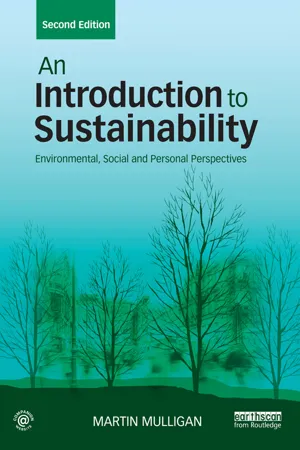
An Introduction to Sustainability
Environmental, Social and Personal Perspectives
- 338 pages
- English
- ePUB (mobile friendly)
- Available on iOS & Android
About this book
An Introduction to Sustainability provides students with a comprehensive overview of the key concepts and ideas which are encompassed within the growing field of sustainability.
The fully updated second edition, including new figures and images, teases out the diverse but intersecting domains of sustainability and emphasises strategies for action. Aimed at those studying the subject for the first time, it is unique in giving students from different disciplinary backgrounds a coherent framework and set of core principles for applying broad sustainability principles within their own personal and professional lives. These include: working to improve equality within and across generations; moving from consumerism to quality of life goals; and respecting diversity in both nature and culture.
Areas of emerging importance such as the economics of prosperity and wellbeing stand alongside core topics including:
· Energy and society
· Consumption and consumerism
· Risk and resilience
· Waste, water and land.
Key challenges and applications are explored through international case studies, and each chapter includes a thematic essay drawing on diverse literature to provide an integrated introduction to fundamental issues.
Housed on the Routledge Sustainability Hub, the book's companion website contains a range of features to engage students with the interdisciplinary nature of sustainability. Together these resources provide a wealth of material for learning, teaching and researching the topic of sustainability.
This textbook is an essential companion to any sustainability course.
Frequently asked questions
- Essential is ideal for learners and professionals who enjoy exploring a wide range of subjects. Access the Essential Library with 800,000+ trusted titles and best-sellers across business, personal growth, and the humanities. Includes unlimited reading time and Standard Read Aloud voice.
- Complete: Perfect for advanced learners and researchers needing full, unrestricted access. Unlock 1.4M+ books across hundreds of subjects, including academic and specialized titles. The Complete Plan also includes advanced features like Premium Read Aloud and Research Assistant.
Please note we cannot support devices running on iOS 13 and Android 7 or earlier. Learn more about using the app.
Information
Chapter 1
Introduction
Author’s Introduction
The Concept as we now know it
Arguments for Hope
To travel hopefully …
Successes and Failures Since 1987

Table of contents
- Cover
- Title
- Copyright
- Dedication
- Contents
- Visual tour
- List of photos
- List of figures
- List of tables
- Preface
- Acknowledgements
- Chapter 1 Introduction
- PART I HISTORY, KEY CONCEPTS AND OPERATING PRINCIPLES
- PART II FINDING FOCUS AND TAKING ACTION
- PART III KEY CHALLENGES AND APPLICATIONS
- Glossary
- Bibliography
- Index